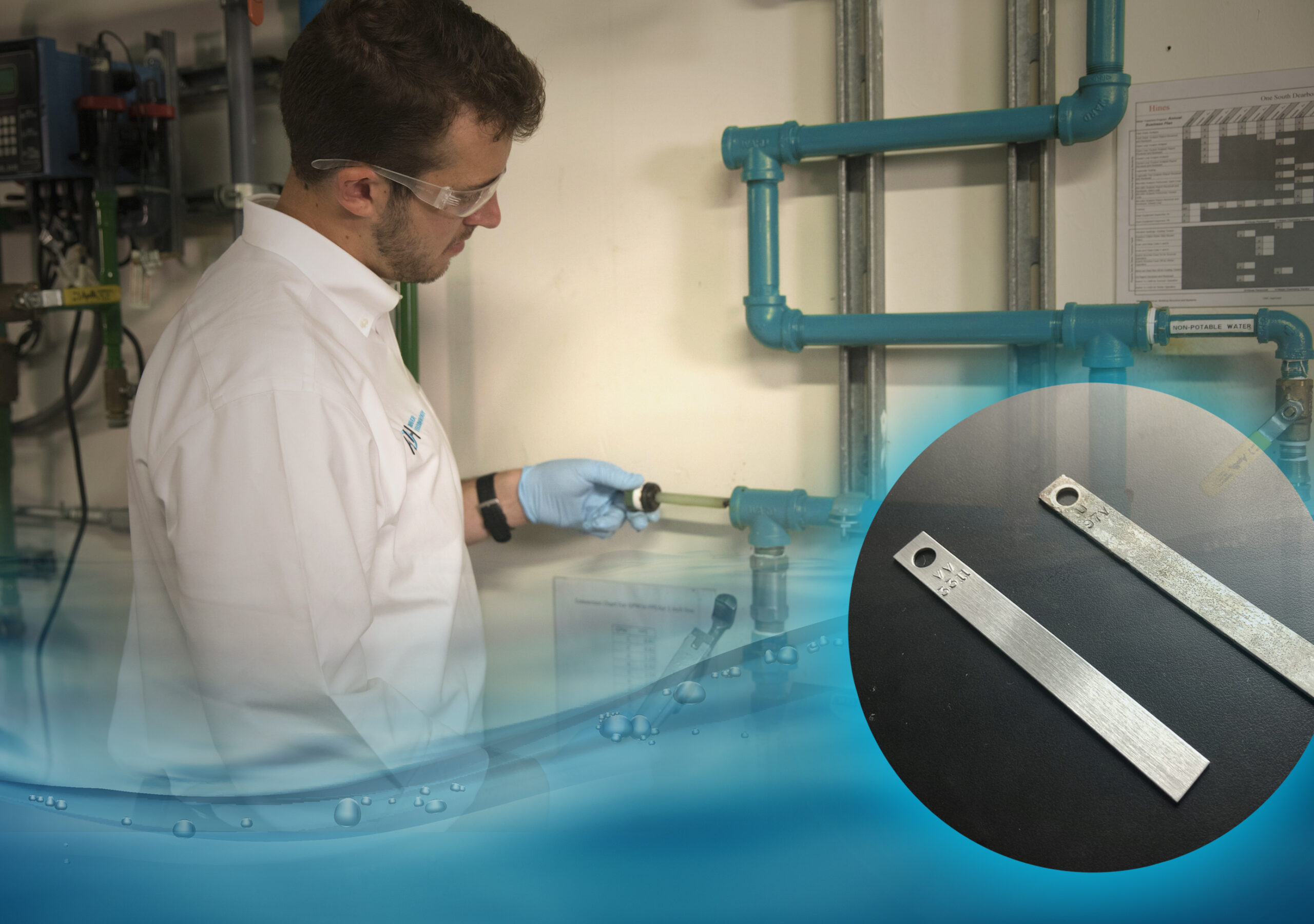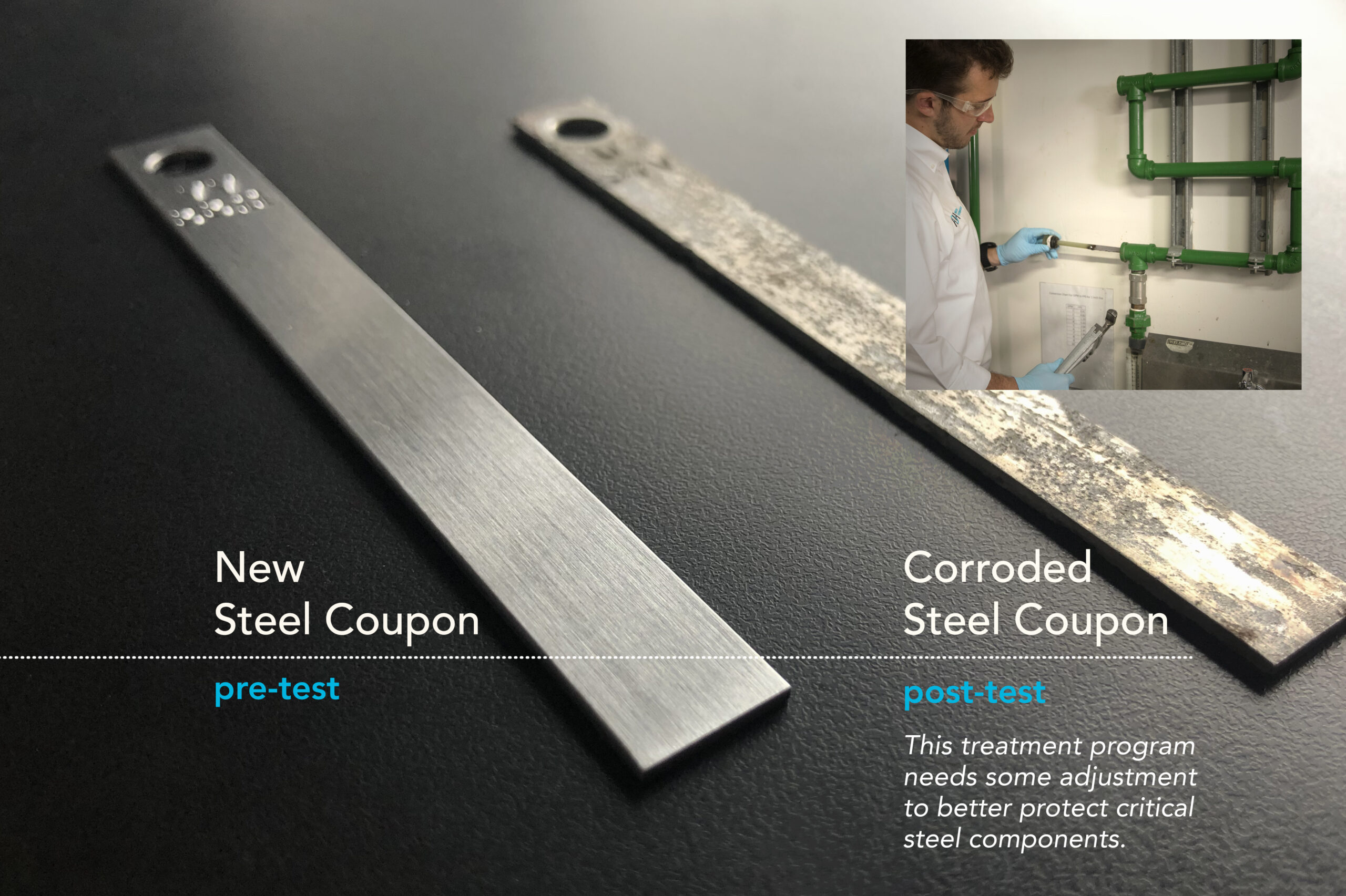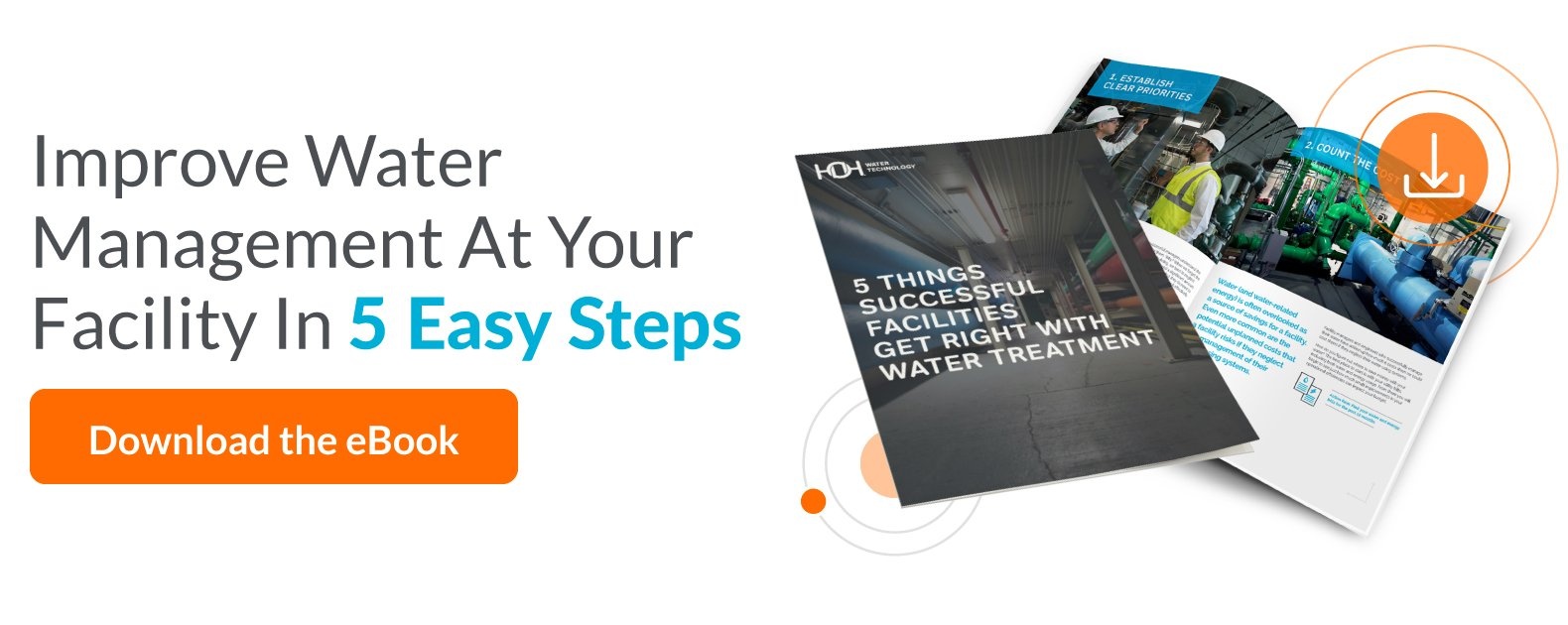
When metal meets moisture, you get rust. Everyone knows that, but rust is only the surface issue in this highly corrosive relationship. Simply put, water eats metal. That’s why your industrial water needs to be treated with a corrosion inhibitor. Even then, if you don’t have the right chemical feed rates or the right formulation, you can eat away at costly metal components and end up having to replace them before their time.
So how do you know if your treatment is actually working? A visual inspection would tell you, but critical heat-transfer surfaces are often hidden away inside your heating, cooling, and process systems, and can’t be seen without a borescope or some major dismantling. That’s where corrosion “coupons” come in.
What are Corrosion Coupons?
No, these coupons won’t give you a discount on your next purchase. Corrosion coupons are small strips of metal that represent the metal components contained in your building’s recirculating water systems. Each coupon strip is measured and pre-weighed. They are then placed in your treated water loop, typically in a coupon rack, to expose them to the conditions of the system for a period of 90 days. After 90 days, you can remove the coupons, visually check them for corrosion and send them to a lab to be cleaned, weighed, and analyzed. The weight loss in the coupon and exposure time will be translated to a corrosion rate in the system for that metal type. The results are a good indication of how the actual metal surfaces inside your systems are faring.
Corrosion coupon materials include stainless steel, copper/copper alloys, low carbon steel, galvanized steel, and aluminum. It’s important to properly identify the metals used in your heating and cooling systems. For instance, if your open cooling loop flows across steel and copper, testing an aluminum coupon won’t tell you anything useful.
How Do You Conduct the Test?
Coupons are held in a pipe system called a coupon rack, which is installed into your recirculating loop at a point after the water has cycled through your cooling or heating system. Within the rack, the most active metal is placed in the first position in the downstream flow of water. This is to prevent noble metals from depositing onto active metals and producing a false coupon reading.
Additionally, the broad face of each metal strip should be in a vertical orientation to reduce the accumulation of debris, which can likewise throw off test results.
Corrosion rates are measured in mils per year (MPY). To get the most accurate rating, coupons are exposed to treated water for 90 days. At that point, the coupons are removed, cleaned, and weighed to determine metal loss and corrosion rating.

Are Corrosion Coupons Worth the Effort?
Corrosion coupons are an easy and inexpensive way to protect your costly HVAC or process components. There is an upfront cost to install the rack, and the lab analyses may or may not be covered in your service contract (contact your water treatment provider if you’re unsure) – but these are minor expenses when compared to the cost of having to replace corroded equipment, or even to perform a cleaning.
Beyond that, a corrosion coupon rack puts one more set of “eyes” on your water treatment program, letting you see and measure the results you’re getting from the dollars you already spend. It also allows your treatment professional to make necessary adjustments and stay ahead of the corrosion curve. Source water chemistry can change over time and require a different dosage of inhibitor. Adjusting other treatment chemicals can also impact corrosion. For instance, if a spike in microbial activity forces you to increase your oxidizing biocide feed, this may adversely affect your corrosion protection. Coupons are a tangible way to monitor the impact of these variables.
Understanding the Test Results
A coupon’s corrosion rate is based on metal loss over a designated time period. The coupons are carefully weighed and logged before and after to determine metal loss. Corrosive “pitting” is also quantified by measuring pitted surface area.
There are several factors that affect corrosion rate, including location, exposure time, pH, water temperature, coupon design/placement, flow velocity, and current water treatments.
Once evaluated, the technician will calculate the rate in mils per year. Each metal or alloy used has its own acceptable corrosion rates.
Stainless Steel
| Evaporative Water Systems | Closed Water Systems | |
| Acceptable | <0.1 MPY | <0.1 MPY |
| Unacceptable | >0.1 MPY | >0.1 MPY |
Copper and Copper Alloys
| Evaporative Water Systems | Closed Water Systems | |
| Excellent | <0.1 MPY | ≤0.1 MPY |
| Very Good | 0.1-0.25 MPY | 0.1-0.15 MPY |
| Good | 0.25-0.35 MPY | 0.15-0.20 MPY |
| Fair | 0.35-0.5 MPY | 0.2-0.3 MPY |
| Poor | 0.5-1.0 MPY | 0.3-0.5 MPY |
| Unacceptable | >1.0 MPY | ≥0.5 MPY |
Low Carbon Steel
| Evaporative Water Systems | Closed Water Systems | |
| Excellent | ≤1.0 MPY | ≤0.2 MPY |
| Very Good | 1.0-3.0 MPY | 0.2-0.3 MPY |
| Good | 3.0-5.0 MPY | 0.3-0.5 MPY |
| Fair | 5.0-8.0 MPY | 0.5-0.8 MPY |
| Poor | 8.0-10.0 MPY | 0.8-1.0 MPY |
| Unacceptable | >10 MPY | ≥1.0 MPY |
Aluminum
| Evaporative Water Systems | Closed Water Systems | |
| Acceptable | <0.2 MPY | <0.2 MPY |
| Marginal | 0.2-0.25 MPY | 0.2-0.25 MPY |
| Unacceptable | >0.25 MPY | >0.25 MPY |
Acceptable corrosion rates from the Association of Water Technologies.
I Know My Corrosion Rate. Now What?
If your corrosion rate comes back within an acceptable range, no action is needed. But don’t forget to place new coupon strips in your rack. This is an ongoing tool that will help you monitor the health of your system components. A number of different variables can change over time, affecting the protection level of your treated water.
If your corrosion rate comes back above the acceptable range, you can work with your water treatment team to create or modify your plan of action. This may require some additional diagnostics to get to the root cause of the problem, but a knowledgeable water treatment professional should be able to get you back on course in short order.
If you would like more information about corrosion coupons or corrosion protection, don’t hesitate to contact us. An experienced HOH Water Quality Engineer will be happy to answer your questions. And while you’re at it, you can ask him or her about the latest automated technology that will give you an instantaneous corrosion reading.
Recent Blog Posts

Five Ways to Increase the Efficiency of Your Closed Loop System

Global 6K for Water

